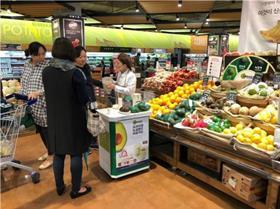
South Korea has emerged as the largest export market for New Zealand avocados behind Australia.
The Asian nation imported more than 145,000 trays of New Zealand fruit over the recently completed 2017/18 season, with returns per tray improving by close to 20 per cent compared to the previous season. The Avanza brand – shipped by New Zealand’s largest avocado export group Avoco – accounted for 66 per cent of this volume.
The growing demand for New Zealand fruit comes amidst an avocado awakening in South Korea.
Just three years ago, South Korea imported 250,000 trays of avocados from all origins. That figure grew to 500,000 in 2016, before jumping to 1.1m traysin 2017. The overall value of the trade was US$31m last year, up from US$12m in 2016.
While not the largest supplier by volume, New Zealand is able to capitalise on this rapidly developing marketby extracting a premium for its fruit. Promotional activity has been central to this push, according to Avanza’s market manager Martin Napper.
“All the work we’ve done to educate consumers on the health benefits of avocados as well teach importers and distributors how to correctly handle and store the fruit, is paying off with increased sales,”Napper explained.
Last year’s promotional activity included an ongoing association between Avanza and Maeil Dairies, one of the largest beverage companies in South Korea. The partnership enabled Avanza to participate in Maeil’s soy milk and avocado smoothie promotions, which were based around far-reaching social media campaigns.
This built on Avanza’s programme of supermarket demonstrations, which has included 1,500 sampling sessions over the past four years, reaching an estimated 600,000 consumers.
South Korean consumers also had the option to purchase a ready-to-eat piece of fruit from entrepiece displays in selected stores – a strategy that drove sales growth by over 300 per cent, according to Napper.
Avanza is now looking to apply this marketing nous to other markets in North and South East Asia.
“We have struck a formula that we know works, so it makes sense to apply the same strategies to all our markets, including Singapore and Thailand – anywhere where we can see potential for real consumption growth as diets become more varied,” Napper explains.
While there appears no shortage of demand for New Zealand avocados, ensuring production can keep pace is another matter.
Last season’s low crop volume meant New Zealand only exported 2.2m avocado trays – less than half the volume shipped offshore over the 2016/17 campaign.
Avoco handled 1.3m trays of this volume, with around 80 per cent sent to Australia, which remains the industry’s highest-paying market.
With China opening its doors to New Zealand avocados earlier this year, all exporters wanted more fruit to maximise the growing market opportunities,
“As an industry, we’re investing in research to achieve more consistent production and planting an extra 1000 hectares in young trees. But it will take time for us to see the benefits of that investment,” says Avoco’s marketing and communications manager, Steve Trickett.
“In the interim, growers have to adapt quickly to meet specific customer market compliance requirements to ensure their fruit can be exported to these new markets being opened. As we grow our markets and consumers develop an appetite for avocados, every piece of fruit counts.”



